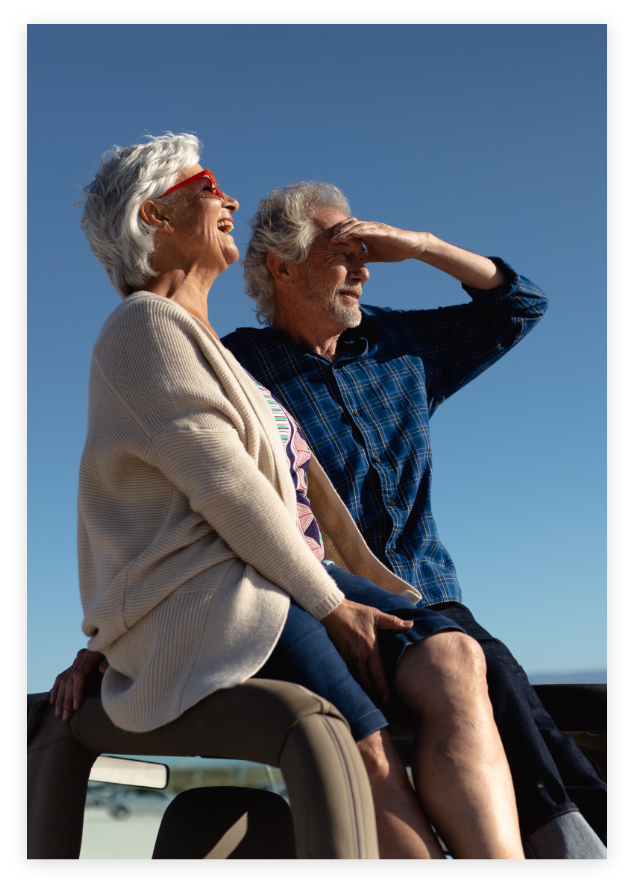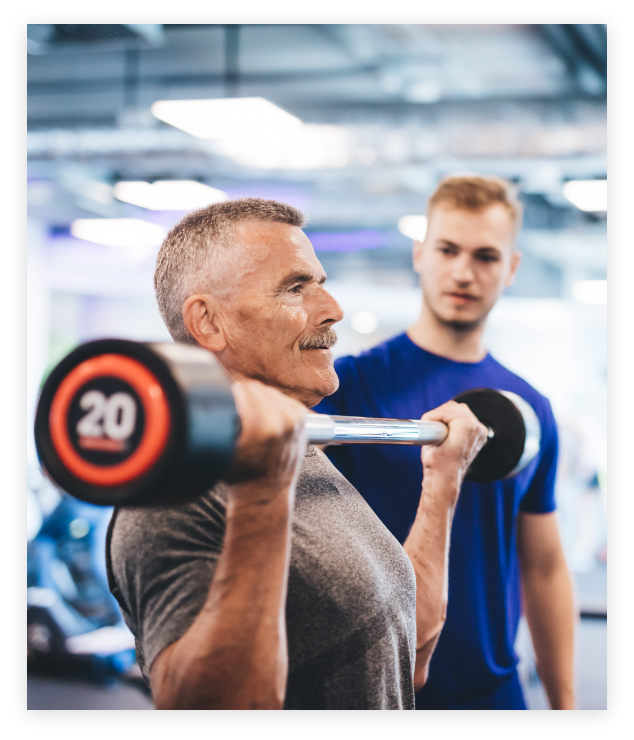

Osteoarthritis is what most people think of when they think of “arthritis.” That is probably because osteoarthritis is by far the most common form of arthritis.
Globally, 1 in 10 men and one in 6 women over the age of 60 have osteoarthritis. Fortunately, individuals seeking osteoarthritis pain relief have several options.


What Is Osteoarthritis?
Osteoarthritis is a disease in which a joint or joints suffer from structural changes that interfere with joint function, cause symptoms, and lead to joint inflammation. Unlike rheumatoid arthritis, the joint inflammation that occurs in osteoarthritis is not due to an autoimmune condition. Instead, osteoarthritis is usually caused by a combination of genetics, obesity, normal wear-and-tear, and in some cases, joint injury.

Osteoarthritis Symptoms
Osteoarthritis symptoms vary from person to person and as the disease progresses. In many people, osteoarthritis symptoms progress along three phases.
Stage 1 Osteoarthritis
Early in the disease, people tend to feel a sharp pain in the affected joint after they perform some activity. For example, a person with early knee osteoarthritis experiences sharp knee pain after making a jump shot in basketball. The symptoms of early osteoarthritis are usually worse when the joint is being used and they get better with rest.
Stage 2 Osteoarthritis
Instead of just being provoked by an activity, a mild joint discomfort is present more or less constantly. Certain activities still produce a sharp pain, but that is on top of a constant, dull pain.
Stage 3 Osteoarthritis
The constant joint pain is now severe and greatly limits function. Episodes of intense pain can happen at any time, with or without some action to provoke it. Stage 3 osteoarthritis is severe and often debilitating.


Osteoarthritis Diagnosis
An osteoarthritis specialist diagnoses osteoarthritis by taking a history, performing a physical examination, and possibly ordering some tests and imaging studies. The osteoarthritis specialist asks the patient to describe the pain, how long the patient has experienced the pain, what makes the pain better and worse.
During physical examination, the osteoarthritis specialist will look for joint tenderness, that is, does pressing on the joint cause pain. Is the joint red, swollen and/or deformed? Is the joint unstable or is its range of motion limited? Is there crepitus (a “crunchy” sensation that can be felt when placing a hand on the joint)?
Blood tests are not needed to diagnose osteoarthritis, but if the joint pain could be due to rheumatoid arthritis or gouty arthritis, the specialist may order blood tests to rule these causes of arthritis out.
While an osteoarthritis specialist can usually diagnose osteoarthritis based on signs and symptoms alone, in some cases, the physician will order one or more imaging studies. The three main types of imaging studies used for this purpose are plain X-ray, MRI, and ultrasound. Each type of imaging study has advantages and disadvantages.
Advantages and Disadvantages of Osteoarthritis Imaging Modalities
Imaging Type
Advantage
Disadvantage
X-Ray
Fast and Inexpensive
Cannot See Soft Tissue
MRI
Excellent View Of Joint
Slow And Expensive
Ultrasound
No Radiation Exposure
Not Always Helpful
If the osteoarthritis specialist suspects the joint is infected or contains crystals (e.g., in gout or pseudogout), a small bit of fluid will be removed and sent for analysis. In patients with pure osteoarthritis, neither of these are present and joint fluid analysis is not needed.


How to Relieve Pain From Osteoarthritis?
(Osteoarthritis Treatment)
No medication, injection, or therapy can stop or reverse osteoarthritis. Fortunately, there are many ways to relieve osteoarthritis pain.
Medications
NSAIDs (oral) — NSAIDs (Nonsteroidal anti-inflammatory drugs) can block mild to moderate osteoarthritis pain and reduce joint inflammation. Ibuprofen and naproxen are available without a prescription. Stronger NSAIDs are available by prescription including meloxicam, piroxicam, celecoxib, diclofenac, and sulindac, among others. While NSAIDs may be helpful over the short term, they may cause serious side effects if used chronically.
Acetaminophen — Acetaminophen can help reduce or block mild to moderate osteoarthritis pain. Acetaminophen tends to cause fewer gastrointestinal and kidney problems than NSAIDs but taking high doses of acetaminophen for a long period can injure the liver.
NSAIDs (topical) — Patients can largely avoid the gastrointestinal and kidney problems associated with oral NSAIDs by using a topical preparation. A topical NSAID (e.g., gel, cream, etc.) is applied to the skin near the osteoarthritis joint pain. Topical NSAIDs may be a good approach for people with mild osteoarthritis pain.
Duloxetine — Duloxetine is an antidepressant medication (Serotonin/Norepinephrine Reuptake Inhibitor; SNRI), but it is also FDA-approved to treat chronic musculoskeletal pain, including moderate to severe osteoarthritis.


Injections
Steroid injections — Steroids are powerful anti-inflammatory medications that can reduce moderate to severe osteoarthritis symptoms. To maximize their effect and minimize their side effects, the steroid (e.g., methylprednisolone, triamcinolone) is injected directly into the affected joint. The intraarticular corticosteroid injection (its medical name) is usually mixed with a local anesthetic like lidocaine to temporarily dull the pain. Steroid injections reduce pain and inflammation for some time but cannot be administered too frequently.
A2M injections — A2M is shorthand for alpha 2 macroglobulin, which is an extremely important protein that occurs naturally in the body. A2M irreversibly binds to proteins that breakdown other proteins (i.e., proteases). When A2M is plentiful, it blocks the action of proteases that breakdown and destroy cartilage and cause inflammation and pain. Unfortunately, older joints do not have enough A2M to block these proteases. Therefore, A2M joint injections can potentially slow cartilage destruction in osteoarthritis and reduce osteoarthritis pain. We are able to concentrate A2M from a blood sample, then inject the concentrate into areas of pain including the spine, knee, shoulder, hip and other joints of the body.
PRP injections — PRP or platelet-rich plasma is the portion of the blood that contains high concentrations of thrombocytes and various healing factors such as growth factors and cytokines. A sample of the patient’s own blood is removed and spun down in a centrifuge. The platelet-rich plasma portion of the sample is removed and injected into the diseased joint. Evidence suggests PRP is effective in treating osteoarthritis; muscle tendon, and ligament injuries; and to speed up healing after surgery.


Physical Therapy
A physical therapist can teach patients how to strengthen the muscles that surround the affected joint, which can help stabilize it. Likewise, physical therapy exercises may be able to increase flexibility and range of motion. A physical therapy program may reduce osteoarthritis pain and increase physical functioning.
Other Forms Of Relief
Weight loss — Carrying excess weight increases the risk of developing osteoarthritis in weight-bearing and non-weight-bearing joints. Conversely, trimming down to a healthier weight can reduce osteoarthritis symptoms in those who are overweight or obese.


Osteoarthritis Surgery
Osteoarthritis surgery like artificial disc replacement can reduce pain, improve symptoms, and increase range of motion. Osteoarthritis surgery is usually not a first-line treatment for osteoarthritis. However unlike other osteoarthritis treatments, osteoarthritis surgery can temporarily or permanently halt the progression of osteoarthritis in the affected joint.
Joint Resurfacing
As osteoarthritis progresses, the joint undergoes structural changes like a breakdown of joint cartilage and growth of bone spurs. For some joints, the surgeon can cover the damaged, natural joint with a metal surface. Most of the bone and joint remains intact, the surfaces of the joint are now covered in metal.
Osteotomy
In some cases, simply removing a small piece of bone (i.e., osteotomy) around the joint can relieve pain and improve joint function. Joint osteotomy is sometimes called realignment surgery since the bone removal usually changes how weight is distributed across the joint and causes a realignment of the bones and joint.


Joint Replacement
A joint replacement, also known as total joint replacement or total joint arthroplasty, is an osteoarthritis surgery in which the affected, natural joint is replaced with an artificial joint. Joint replacement can relieve osteoarthritis pain and symptoms and, unlike fusion, can preserve or enhance the joint’s range of motion.
Fusion
In joint fusion surgery, the bones on either side of the affected joint are fused together with natural or artificial bone. The bones are held together with hardware (e.g., screws, plates, rods) until the joint fuses, essentially by the same process by which broken bones knit together. Joint fusion can relieve osteoarthritis joint pain, but the joint no longer moves as a joint. Fusion surgery used to be a common osteoarthritis surgery for knee and hip osteoarthritis until knee and hip replacements became widely available.


Scheduling an Appointment With an Osteoarthritis Specialist
To get the most out of your appointment with an osteoarthritis specialist, it helps to prepare. Since a major part of making an osteoarthritis diagnosis depends on history, be prepared to answer questions about when your pain started, what you have tried to relieve your osteoarthritis pain, and if there is anything that may have made it worse, like an injury. If you have had X-rays or MRI, try to have a copy of the report or, ideally, a copy of the actual images sent to the osteoarthritis specialist before your visit. Likewise, if you have had any bloodwork or fluid analysis of the joint, your osteoarthritis specialist will want to review these results. Lastly, if you have seen other doctors or specialists about your osteoarthritis in the past, it can sometimes be helpful for the osteoarthritis specialist to see those notes.
Ready to reclaim your life? Get in touch with Dr. Lanman Today.
FOLLOW US ON SOCIAL MEDIA | @ADRSPINE



